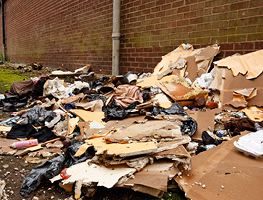Table of Contents:
What is Bulky Waste?
‘Bulky waste’ is a category of waste items that are too large or oversized to be stored in regular waste bins and accepted by household waste collection. This can include items such as furniture and large appliances like ovens and refrigerators, televisions and electronic devices, and plumbing fixtures, such as sinks and toilets.
Options for Bulky Waste Disposal
- HWRC: For households with access to vehicles, a trip to the local Household Waste Recycling Centre (HWRC) presents the most cost-effective and accessible solution for bulky waste disposal. However, operating policies will be in place that restrict certain items or incur additional charges for disposal, while it’s worth considering that there are typically height restrictions for larger vehicles, as well as the use of trailers.
- Council Collection Service: Council collections are an effective solution for households without access to a vehicle and don’t involve the cost expenditure of hiring a van. However, free council collections are increasingly rare and most will charge for collection per individual item. The criteria for this service also typically rely on users storing their bulky waste items on the street, either the night before or early in the morning, as they await collection, which can be restrictive for some properties whilst creating a negative visual impact and potentially attracting opportunities for vandalism or arson.
- Independent Contractors: There are a number of independent contractors and collection companies who will offer paid collection services for bulky items. The appeal of these is the ability for households to book a timeslot and most services will access the respective property to collect the bulky waste items. However, the cost factor can be restrictive for some as it is usually higher than council collections and research will often need to be undertaken to ensure these services are professional and offer quality of service, with some protection in place to protect residents’ property from damage.
- Charity donation: Most charities can accept bulky items as donations, however, there are typically a few conditions. Accepted furniture must be in an accepted condition to enable resale, while items like chairs and sofas will also require an attached fire label to ensure they have passed safety regulations. Most charities will offer a collection service for bulky waste items that meet their criteria, however, this isn’t universal.
Challenges for Communal Environments
With the criteria for collection services often relying on users storing their items in a safe and secure location; typically near the front of prospective property or on the street, to await collection, this can be very restrictive for communal properties with a lack of external space. Residents in high-rise buildings without potential lift access can also face great difficulty transporting their bulky waste items to street level, while this is largely impossible for those with mobility restrictions.
A lack of effective storage options for residents in these circumstances can then lead to dumping in communal areas, with landlords potentially incurring high removal & disposal costs so that the well-being of other residents and the appearance of their properties is maintained.
Ensuring there are effective storage options for bulky waste items awaiting collection in communal environments should ultimately be regarded as a collective responsibility that requires the active involvement of residents, landlords, and local authorities. In their Reuse, Recycling & Waste Strategy, London Borough of Tower Hamlets raises a clear recommendation for every new residential development in the borough to provide short-term storage for bulky waste.
Requirements for Bulky Waste Storage
For bulky waste storage facilities to be effective there are certain requirements that should be incorporated into the design. Ensuring these requirements are in-place will help to maximise secure use, accessibility and the longevity of the facility.
- Safe and Secure: A designated facility for bulky waste storage needs to be secure as a primary concern. The facility should be set in or fixed to a permanent structure while integrating locking systems or a means of access control is key to restricting unauthorised access and potential vandalism.
- Space Planning: This needs to be considered to ensure the facility is safely positioned and unable to cause obstructions. If the facility needs to be accessed by collection crews, it must be in a prominent position near the respective property that enables easy access.
- Durability of Materials: Utilising durable materials that can withstand demanding urban environments is key to maintaining the integrity of the designated storage facility. An enclosed design provides effective cover and helps to ensure the bulky waste items stored inside aren’t exposed to inclement weather.
metroSTOR Bulky Waste Storage
Offering the means to capture bulky waste at the source, metroSTOR provides versatile, durable outdoor storage units for bulky waste items, ideal for utilisation across sectors from facilities departments to social housing. For landlords, this can be key to reducing bulky waste disposal costs and improving the quality and appearance of communal environments.
Neatly styled to complement surrounding building design and reduce visual impact, access control options and security fixings ensure that bulky waste items secured inside cannot be removed by unauthorised individuals as they await collection, even if the panel integrity is compromised.









